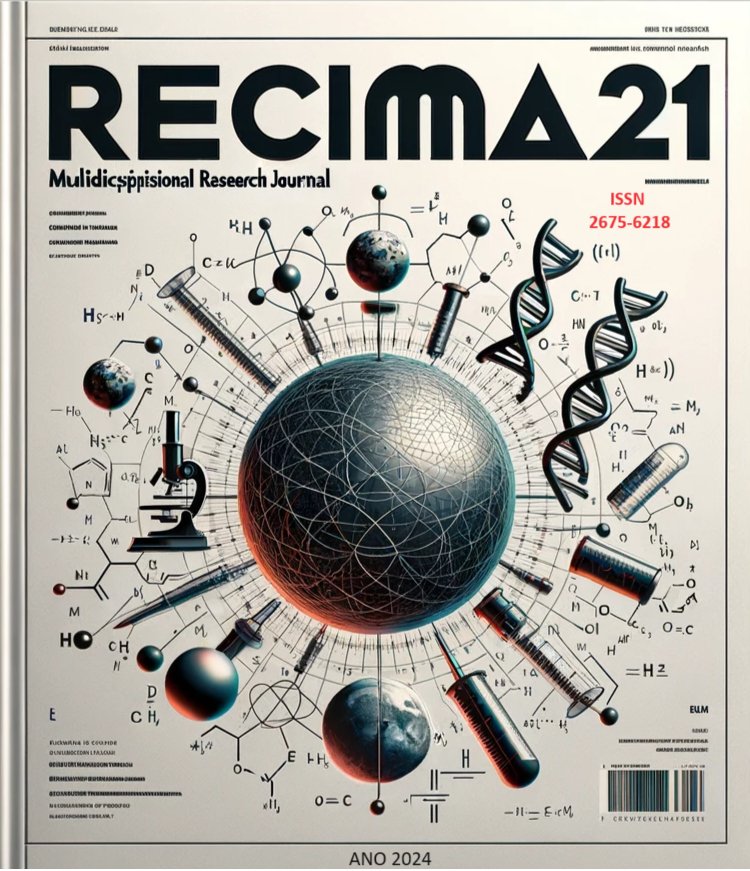NARCISSISTIC PERSONALITY DISORDER: A REVIEW OF THE LITERATURE ON THE NEUROBIOLOGICAL FACTORS, DIAGNOSIS AND TREATMENT INVOLVED
DOI:
https://doi.org/10.47820/recima21.v5i4.5105Keywords:
Narcissistic Personality Disorder. Neurobiological factors. Diagnosis. Treatment. Therapeutic approaches.Abstract
Introduction: Narcissistic Personality Disorder (NPD) is a complex psychiatric condition that has received increasing attention due to its clinical relevance and impact on interpersonal relationships and social functioning. Objetctive: This literature review aims to explore the neurobiological factors, diagnosis and treatment of NPD. Methods: A bibliographic review of the scientific literature was carried out using databases such as PubMed, Web of Science, Scopus and Google Scholar. The inclusion criteria were studies published from 2009 to 2024, in English, Portuguese or Spanish, which addressed neurobiological aspects, diagnosis, treatment or future perspectives of TPN. Results and Discussion: The results of the review highlight the importance of neurobiological factors in the etiology of TPN, the complexity of differential diagnosis and the challenges in treatment, including patients' resistance to change. Therapeutic strategies such as Cognitive-Behavioral Therapy (CBT) and neuromodulation were discussed as effective options, but they require adaptation to patients' individual needs. Conclusion: The literature review provides a comprehensive overview of TPN, emphasizing the continued need for advances in the understanding and management of this condition. Future prospects include longitudinal research, the development of personalized therapeutic approaches and further neurobiological studies to improve the diagnosis and treatment of TPN.
Downloads
References
AMERICAN PSYCHIATRIC ASSOCIATION et al. DSM-5: Manual diagnóstico e estatístico de transtornos mentais. Porto Alegre: Artmed, 2014.
BARBATO, Angelo et al. From residential care to supported housing. Frontiers in Psychiatry, v. 11, p. 562200, 2020. DOI: https://doi.org/10.3389/fpsyt.2020.00560
CAMPBELL, W. Keith; FOSTER, Joshua D. The narcissistic self: Background, an extended agency model, and ongoing controversies. In: The self. [S. l.]: Psychology Press, 2011. p. 115-138.
CHOU, S. Patricia et al. The epidemiology of DSM-5 nicotine use disorder: results from the National Epidemiologic Survey on Alcohol and Related Conditions-III. The Journal of clinical psychiatry, v. 77, n. 10, p. 6529, 2016. DOI: https://doi.org/10.4088/JCP.15m10114
CROWE, Michael L. et al. Narcissism and narcissistic personality disorder: Moving toward a trifurcated model. Journal of Personality, 2019.
EATON, Nicholas R. et al. Narcissistic personality disorder and the structure of common mental disorders. Journal of personality disorders, v. 31, n. 4, p. 449-461, 2017. DOI: https://doi.org/10.1521/pedi_2016_30_260
EMMELKAMP, Paul M. G.; MEYERBRÖKER, Katharina. Personality disorders. [S. l.]: Psychology Press, 2019. DOI: https://doi.org/10.4324/9781351055901
FOX, Daniel J. Antisocial, Narcissistic, and Borderline Personality Disorders: A New Conceptualization of Development, Reinforcement, Expression, and Treatment. [S. l.]: Routledge, 2020. DOI: https://doi.org/10.4324/9780429266195
GAREY, Lorra et al. Directional effects of anxiety and depressive disorders with substance use: A review of recent prospective research. Current Addiction Reports, v. 7, p. 344-355, 2020. DOI: https://doi.org/10.1007/s40429-020-00321-z
GEORGE, Holly. Accelerated Intermittent Theta Burst (aiTBS) Treatment for Treatment Resistant Depression; Associations with Borderline Personality Disorder Features. 2021. Tese (Doutorado) - Palo Alto University, [S. l.], 2021.
LENZENWEGER, Mark F. Narcissistic personality disorder studied the long way: predicting change in narcissistic pathology during college. American Journal of Psychotherapy, v. 76, n. 1, p. 15-25, 2023. DOI: https://doi.org/10.1176/appi.psychotherapy.20220020
MINERVINI, Anthony et al. Excitatory dorsal lateral prefrontal cortex transcranial magnetic stimulation increases social anxiety. Brain Sciences, v. 13, n. 7, p. 989, 2023. DOI: https://doi.org/10.3390/brainsci13070989
NENADIĆ, Igor; LORENZ, Carsten; GASER, Christian. Narcissistic personality traits and prefrontal brain structure. Scientific reports, v. 11, n. 1, p. 15707, 2021. DOI: https://doi.org/10.1038/s41598-021-94920-z
PINCUS, Aaron L.; LUKOWITSKY, Mark R. Pathological narcissism and narcissistic personality disorder. Annual review of clinical psychology, v. 6, p. 421-446, 2010. DOI: https://doi.org/10.1146/annurev.clinpsy.121208.131215
RONNINGSTAM, Elsa; BASKIN-SOMMERS, Arielle R. Fear and decision-making in narcissistic personality disorder—a link between psychoanalysis and neuroscience. Dialogues in clinical neuroscience, v. 15, n. 2, p. 191-201, 2013. DOI: https://doi.org/10.31887/DCNS.2013.15.2/eronningstam
ROUSSOS, Panos; SIEVER, Larry J. Neurobiological contributions. The Oxford handbook of personality disorders, p. 299-324, 2012. DOI: https://doi.org/10.1093/oxfordhb/9780199735013.013.0015
SCHULZE, Lars et al. Gray matter abnormalities in patients with narcissistic personality disorder. Journal of psychiatric research, v. 47, n. 10, p. 1363-1369, 2013. DOI: https://doi.org/10.1016/j.jpsychires.2013.05.017
SPERRY, Len; SPERRY, Jon. Core Clinical Competencies in Counseling and Psychotherapy: Becoming a Highly Competent and Effective Therapist. [S. l.]: Routledge, 2023. DOI: https://doi.org/10.4324/9781003251262
SWEARER, Susan M.; HYMEL, Shelley. Understanding the psychology of bullying: Moving toward a social-ecological diathesis–stress model. American Psychologist, v. 70, n. 4, p. 344, 2015. DOI: https://doi.org/10.1037/a0038929
WEINBERG, Igor; RONNINGSTAM, Elsa. Narcissistic personality disorder: Progress in understanding and treatment. Focus, v. 20, n. 4, p. 368-377, 2022. DOI: https://doi.org/10.1176/appi.focus.20220052
Downloads
Published
How to Cite
License
Copyright (c) 2024 RECIMA21 - Revista Científica Multidisciplinar - ISSN 2675-6218

This work is licensed under a Creative Commons Attribution 4.0 International License.
Os direitos autorais dos artigos/resenhas/TCCs publicados pertecem à revista RECIMA21, e seguem o padrão Creative Commons (CC BY 4.0), permitindo a cópia ou reprodução, desde que cite a fonte e respeite os direitos dos autores e contenham menção aos mesmos nos créditos. Toda e qualquer obra publicada na revista, seu conteúdo é de responsabilidade dos autores, cabendo a RECIMA21 apenas ser o veículo de divulgação, seguindo os padrões nacionais e internacionais de publicação.













